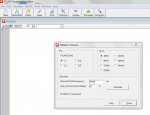Hi, folks.
I'm in the process of converting a (mostly) working project from a BS2 to an 08M2, and I'm seeking suggestions as to how this might best be done. The BS2 can only do one thing at a time, so it's a kluge at best.
I'm counting pulses from a microphone, and using the value of the pulse count to toggle one of 15 pins which determines the output frequency of a tone generator. The pulses are very narrow bandwidth (0-20 Hz) and it doesn't need accuracy.
Is the 08M2 is fast enough to let me eliminate the tone generator altogether? Actually I think the real question is, can an 08M2 count pulses and generate tones simultaneously - better that a Stamp? The Stamp can't without skipping badly.
How would you code these two tasks for maximum speed, please?
I'm in the process of converting a (mostly) working project from a BS2 to an 08M2, and I'm seeking suggestions as to how this might best be done. The BS2 can only do one thing at a time, so it's a kluge at best.
I'm counting pulses from a microphone, and using the value of the pulse count to toggle one of 15 pins which determines the output frequency of a tone generator. The pulses are very narrow bandwidth (0-20 Hz) and it doesn't need accuracy.
Is the 08M2 is fast enough to let me eliminate the tone generator altogether? Actually I think the real question is, can an 08M2 count pulses and generate tones simultaneously - better that a Stamp? The Stamp can't without skipping badly.
How would you code these two tasks for maximum speed, please?
Last edited:



